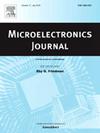An enhanced interlocked feedback structure-based dual-node upset resilient latch
IF 1.9
3区 工程技术
Q3 ENGINEERING, ELECTRICAL & ELECTRONIC
引用次数: 0
Abstract
As the integrated circuit technology continues to scale down, the design of Double Node Upset (DNU) resilient latches has become a critical challenge in radiation-hardened design. Traditional designs of resilient latches are primarily based on the Dual Interlocked Storage Cell (DICE) and novel feedback mechanisms. However, these conventional approaches often suffer from significant limitations, such as instability or errors in logic states due to charge sharing during latching, or trade-offs among power consumption, delay, and area. To overcome these challenges, this paper proposes a DNU-resilient latch based on an enhanced interlocked feedback structure. The proposed ISR latch leverages its interlocked feedback mechanism to achieve self-recovery for the maximum number of double-node upset pairs. Simulation results based on the SMIC 28 nm process model demonstrate that the proposed latch can achieve self-recovery under any double-node disturbance. Compared to existing advanced DNU-resilient latches, the proposed design shows superior performance and power efficiency, achieving an average reduction of 81.67% in PDAP.
求助全文
约1分钟内获得全文
求助全文
来源期刊

Microelectronics Journal
工程技术-工程:电子与电气
CiteScore
4.00
自引率
27.30%
发文量
222
审稿时长
43 days
期刊介绍:
Published since 1969, the Microelectronics Journal is an international forum for the dissemination of research and applications of microelectronic systems, circuits, and emerging technologies. Papers published in the Microelectronics Journal have undergone peer review to ensure originality, relevance, and timeliness. The journal thus provides a worldwide, regular, and comprehensive update on microelectronic circuits and systems.
The Microelectronics Journal invites papers describing significant research and applications in all of the areas listed below. Comprehensive review/survey papers covering recent developments will also be considered. The Microelectronics Journal covers circuits and systems. This topic includes but is not limited to: Analog, digital, mixed, and RF circuits and related design methodologies; Logic, architectural, and system level synthesis; Testing, design for testability, built-in self-test; Area, power, and thermal analysis and design; Mixed-domain simulation and design; Embedded systems; Non-von Neumann computing and related technologies and circuits; Design and test of high complexity systems integration; SoC, NoC, SIP, and NIP design and test; 3-D integration design and analysis; Emerging device technologies and circuits, such as FinFETs, SETs, spintronics, SFQ, MTJ, etc.
Application aspects such as signal and image processing including circuits for cryptography, sensors, and actuators including sensor networks, reliability and quality issues, and economic models are also welcome.
 求助内容:
求助内容: 应助结果提醒方式:
应助结果提醒方式:


